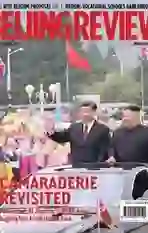Memento of a Maestro
2019-07-09ByPamelaTobey
By Pamela Tobey

White. Black. Bright blue. Those colors frame my artistic impression of Suzhou. The ancient citys historical areas, its distinctive low white buildings with black trim and roofs offered a stark contrast to the intensely blue skies during my recent visit to the city long known as the “Venice of the East.”
Wandering around the lanes and bridges of the traditional water town in east Chinas Jiangsu Province, I kept seeing scenes I wanted to draw or paint. But I hadnt brought my watercolor kit, and with only one day to see everything on our list, there just wasnt time to pause for artistic pursuits.
The area did indeed remind me of Venice, with small boats plying the orderly canals, the stone bridges crossing the water and surrounding graceful old buildings and small shops. Visiting on a weekday meant I saw more of the real life of the town instead of tourists, with grandmothers leading toddlers down the pathways and residents shopping for fruit and vegetables at small shops.
The largest of Suzhous famed walled gardens, the Humble Administrators Garden, surprised me. Because of its name, I had imagined it would be simpler, refl ecting its name. But it isnt humble at all inside. The many canals and lakes, bamboo groves and zigzagging bridges anchor beautiful pavilions and large rock formations that give it a sense of serenity despite the tide of humanity. Its size is a plus, ensuring short periods of serenity while still surrounded by crowds.
Another advantage to seeing this garden is its location next door to the Suzhou Museum. The museum was designed by I.M. Pei, one of my favorite architects, which would have put it on my list anyway. Since Pei died recently at the age of 102, it felt important to see it on this visit.
I had been exposed to Peis architecture many times since my school days in my U.S. home state of Texas. The closest big city to my small home town is Houston, where Pei designed a six-sided, granite-clad skyscraper downtown that is still the tallest building in the city and prominent on the skyline. Not far from my university, also in Texas, is his acclaimed Dallas City Hall, an inverted triangle of a building that always made me wonder just how he achieved such stability with that shape.
After I moved to Washington, D.C., I was a frequent visitor to the National Gallery of Art and its Pei-designed East Building. I remember how awed I was the fi rst time I saw his glass pyramid at the Louvre in Paris. I got to visit his building for the Rock and Roll Hall of Fame and Museum in Ohio, with its melding of different geometric forms perched on the shores of Lake Erie.
Upon entering the Suzhou Museum, we stopped in the orientation room and viewed a documentary film about Pei and the museum. Lining a shelf along one side of the wall were small bunches of flowers left by visitors and condolence books that they could sign in memory of the famed architect.
After seeing some of the traditional architecture of the 2,500-year-old city, it was easy to spot the classical Chinese elements that were incorporated into Peis modern design. From the white walls and black trims to the wooden beams and thin slats on the ceilings and the windows that framed artistically composed scenery, it was a masterful synthesis of the citys architectural tradition in a modern form. Everywhere I turned I found a view that had been carefully considered and beautifully composed.
The exhibition rooms were carefully arranged and led us around in a logical order. One exhibit refl ected the luxury and refi nement described by Marco Polo during his China travels with relics excavated from tombs of the Yuan and Ming dynasties (1279-1644). Other rooms held a focused display of intricately painted porcelain from the 13th to the 19th century. Bold red dragons curled around the center of a large blue and white bowl. A tall white vase was graced with blue outlines of peonies and swirling leaves.
The paintings and calligraphy room—full of Ming and Qing era (1368-1911) scrolls and fans—caught my eye. The scrolls were unrolled behind glass. Large mountain landscapes with tiny figures and buildings gave me a sense of the grandeur of the subject. Large pink peonies swept up one scroll, while the one next to it had a riot of white plum blossoms framed with dark green leaves. I can only hope that someday I can paint Chinese fl owers with such grace, not to mention the graceful characters of the poetry on other scrolls and fans.
Even the little tea shop, where we stopped for a rest and refreshments, was in a beautiful room with a high ceiling and a large cloudshaped window with a lattice of geometric shapes that gave a modernist feel to the view of tall green bamboo growing against a white wall outside the window.
Although too short, my visit to Suzhou bathed my artistic soul in joy, from its traditional architecture, gentle canals and beautiful old gardens to the modern melding of Suzhou traditions by Pei. I cant wait to return. And next time, I will bring my watercolor supplies.
